Showit SEO Guide: How to Rank Your Showit Site on Google

Showit is a website platform specifically for photographers, and is known for making complex design much easier with a simple drag and drop interface. Because of the easy editing interface, beautiful pre-made templates, and a support team that makes it easy to get started, Showit has become an extremely popular photography website platform.
In this post, we’ll talk about Showit’s SEO capabilities. If you’re a Showit user, this guide will help you avoid the most common SEO problems, so you can have the best rankings possible with your Showit site.
Let’s get right to the question you are probably asking…
Is Showit good for SEO?
It is possible to have a site that ranks very well on Google with Showit. For most users, there are some major considerations and extra steps you’ll need to take if you want your SEO to be excellent.
In many ways, SEO for your Showit site is going to be exactly the same as SEO for any other website builder or platform. This article will focus on the things that are unique to Showit SEO.
Pre-requisites
There are a few things to consider before you even get started with this guide. Also, some Showit SEO problems have been fixed for new sites, but the fixes have not been applied to all existing sites before the fix was available.
Choose the right package
Showit has three plans you can choose when you sign up. The “Showit” package, the “Showit + Basic Blog” package and the “Showit + Advanced Blog” package.
If you are serious about SEO, you really shouldn’t consider any package other than the Advanced Blog package.
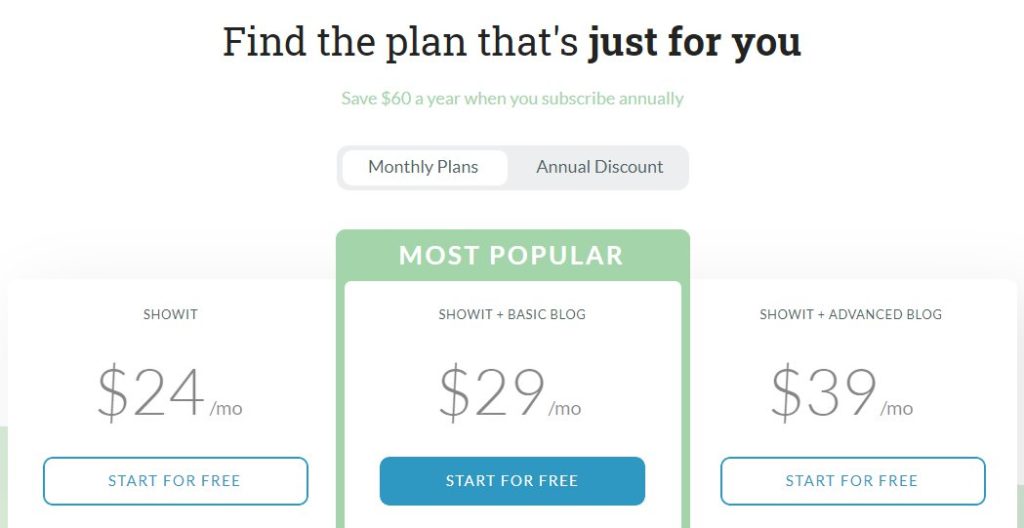
Note: I am not affiliated with Showit. There are no affiliate links for Showit in this article. My only goal is to teach you what I have learned by helping hundreds of Showiteers over the years.
The Basic Blog package may seem like enough at first glance (and they have it highlighted as “most popular”), but there are a couple of downsides right out of the gates.
- You won’t be able to add any plugins outside of their pre-installed plugin list.
- The Basic Blog package will have your WordPress site setup as part of a multisite installation. I won’t get into the technical implications of this, but just know it isn’t ideal.
- You won’t have FTP or database access if you ever need it.
- I generally see more migration mistakes by the Showit team when migrating from another WordPress site into the Basic Blog package.
So the first rule of great Showit SEO is to sign up with the Advanced Blog package.
Fix legacy issues
For the rest of this guide, I will assume that you are using Showit 5 (pretty sure there are no other options anymore), you have an SSL certificate (make sure you get all check marks on whynopadlock.com), and that your WordPress site address and URL are displaying https.
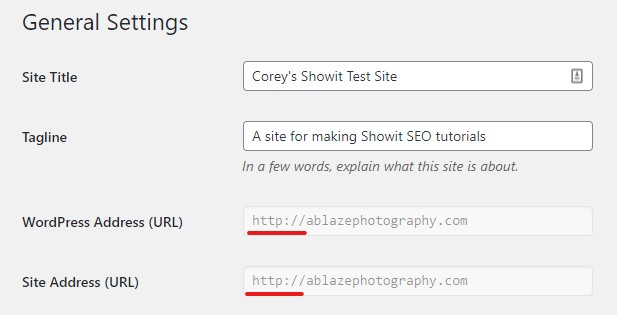
If any of these are not the case, contact Showit support to help resolve the issues.
Migration to Showit
In my experience helping optimize Showit websites, many of the biggest technical issues I’ve found have happened during the initial migration process.
If you are migrating from another WordPress site or from Squarespace, pay close attention to this section so that you don’t completely tank your rankings. If you are starting your site for the first time on Showit, you may still want to double check the settings I mention in this section.
Need an SEO professional to help with your site migration? You can hire us for hourly consulting here!
WordPress “Site Title” & General Settings
By default, Showit will use your domain as the Site Title in WordPress. The problem with this is that if you are also using Yoast, the default settings will add the Site Name to the end of every page title on your site. The ideal Site Title is simply your brand name (exactly the way it appears in Google My Business).
You also need to check your “Administration Email Address” if you want to get any system emails from WordPress or any plugins you are using.
When migrating from another WordPress site, the migration team will not always update these general WordPress settings.
Permalinks
In WordPress, the default Permalink setting will be “Day and name.” However, most people prefer to use “Post name” for cleaner URLs. Many times, during a migration, your permalinks may change back to day and name. If this happens, Google will have to drop all of your post URLs from the index and re-index the new URLs. By default, there won’t be any redirects to the permalink change, which can also lead to 404 errors when people visit the old links.
The key for migrations is to make sure that your permalinks do not change. The Showit migration team will not necessarily handle this for you and may leave the default settings.
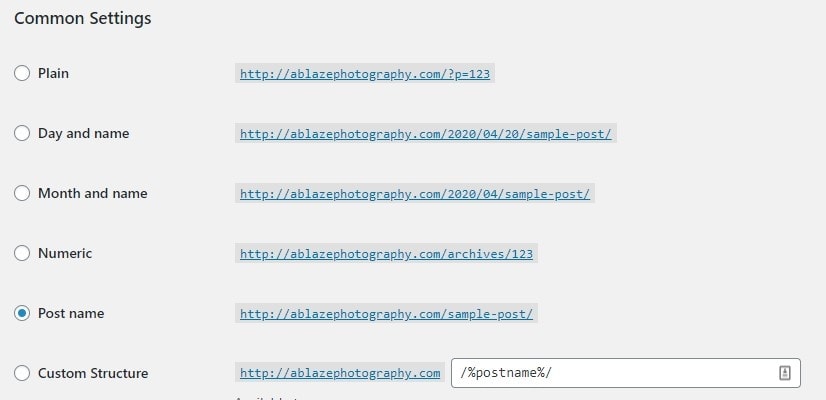
WordPress pages
If you are migrating to Showit from another WordPress site, Showit will migrate both your posts AND pages to the new Showit server.
Most Showit designs do not come with a template to handle displaying content for WordPress pages. Also, most people moving to Showit decide that they will build the main “pages” on Showit, and don’t need these old WordPress pages at all. More on that later…
If you migrated pages from another WordPress site, you have two options:
- Delete these pages from WordPress
- Create a WordPress template in the Showit builder to allow content from these WordPress pages to display properly
If you do not do one of these two things, the page URLs will be accessible (if you don’t replace them exactly with Showit pages) and can still be indexed by Google, even though the full page content will not be present.
Plugin settings
During a migration, what happens to your plugin settings will depend on which package you selected. The basic blog will not include ANY plugin settings, and any plugins that you were using that are not included in the pre-installed plugin list will no longer be available.
If you have the Advanced Blog package, your plugins should be migrated along with your site’s content. Even so, you may want to back up your plugin settings, especially with plugins like Yoast or Redirection. These plugins will allow you export all settings so that you can re-import them if they do not migrate correctly.
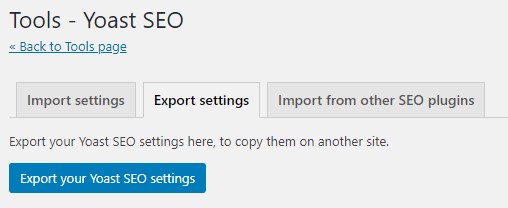
Redirects
If you had redirects set up before moving to Showit (or URL mappings as Squarespace calls them), they will not necessarily be migrated to Showit. This won’t be an issue for everyone, but if you’ve already started working on your SEO and you have redirected old content to new URLs, you’ll want to make a note of those redirects or back them up so you can reapply them on Showit.
Canonical Address (www)
In some cases, during the migration to Showit, I’ve seen the canonical address changed from www to non-www. This isn’t necessarily a problem as long as you are aware, redirects are set up properly, and you make sure that you have the non-www property set up in Search Console. You will also want to change the link in your Google My Business profile if you switch from www to non-www.
Showit can configure your site with www, so if you want to keep it, just make sure to let them know before the migration!
Showit Basic SEO Settings – Quick Review
There are many tutorials out there that will cover basic SEO settings in Showit. Even the Showit documentation does a good enough job of covering these basic features. I’ll list a few of them here, along with any necessary clarifications or links to official documentation.
Analytics (UA code)
Setting up Google Analytics on Showit is extremely easy. First, you’ll need to set up your Google Analytics account so you can get your unique “UA code.” Once you do that, all you have to do is paste it into the Showit Site Settings>Third Party>Google Analytics ID box!
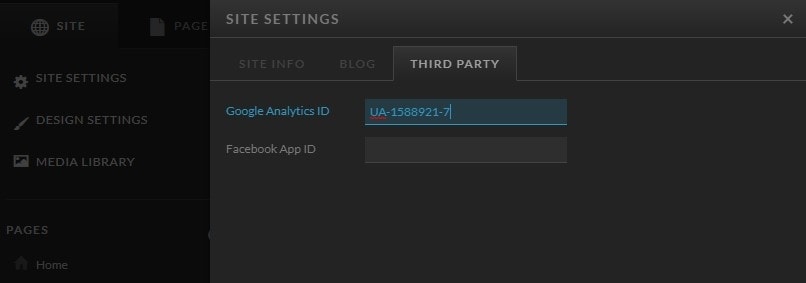
Once you do this, your Analytics code will be included on every page (and post) on your website. You do not need to paste the code into the “head” area of any pages, and you do not need any Google Analytics plugins for WordPress. If you plan to use another method to implement Google Analytics, do not include your UA code in the Showit settings.
Showit’s official documentation on adding Google Analytics to your site
Showit page SEO settings
Every Showit page has an “SEO Settings” tab where you can edit the page title, meta description, meta keywords, and share image.
Page Title
When you’re working on your page title and meta description, it can be really helpful to use a SERP (search engine results page) simulator. Here’s our current favorite SERP simulator.
Simulators like these won’t be perfect, but they’ll help you estimate length limits and get an idea of how your site might appear on Google.
Here are a few tips for page titles:
- If you keep your title to around 55 characters, the entire title will likely fit on most devices/displays.
- Your home page title should include your primary keyword + your business name. Example: Columbia SC Wedding Photographer: Ablaze Photography.
- Don’t use the same keyword (or close variations) on multiple pages. One page per topic!
- Use keywords intentionally, but don’t stuff keywords into your titles. The title should indicate the main topic or purpose of the page and convince people to click.
Meta Description
A meta description is like a little mini ad to get someone to click on your result when it shows up in search engines. Don’t stuff keywords here, just write a short description of the page that tells someone how it can help them. Most often, meta descriptions get cut off between 140 and 160 characters, but some can be up to 320 characters.
Meta Keywords
This one is easy! Just leave it blank. Google doesn’t use meta keywords and hasn’t for years!
Share Image
Here, you can set an image that will be used when the page is shared on social media. If you set this and it still isn’t working properly for you when you share on Facebook, head over to the Facebook Debugger, debug the URL, and click “scrape again” (you may have to click it more than once).
Advanced Settings
There are more settings under the “Advanced” tab, including the ability to add custom code to the head of the page, and the ability to request that Google not index the page (a checkbox labeled “Ask Google to ignore this page”).
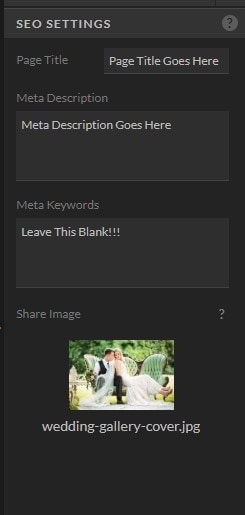
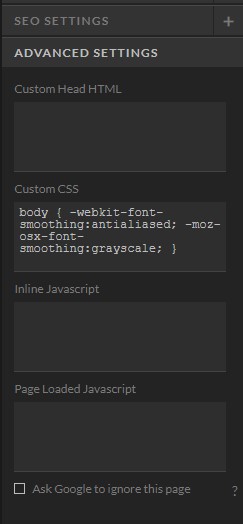
Images (alt text vs title)
With Showit, there are a few ways you can insert an image. Let’s go over them and how to optimize each.
Standalone images
You can insert a single image onto a page as a graphic object. When you click that object, you’ll be able to access the image settings in the right sidebar.
These fields are labeled a bit funky, but you can leave the “SEO Title” field blank, and put your alt text (describe the photo in a ~15 word sentence) in the “Description” field. If you fill out ONLY the “SEO Title,” it will be used as both the image title and alt text. If you fill out both fields, the “SEO Title” is used as the image title, and the “Description” is used for the alt text.
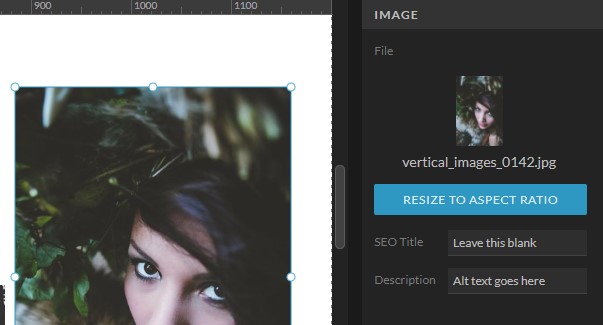
Because of the way the Showit builder places images (as a background), they use a workaround to insert the alt text into the code. Google is able to see this, but don’t be surprised if another SEO tool doesn’t crawl it properly. Here’s what it looks like in the code:

Gallery of images
You can also insert a gallery of images. Once you click the gallery, you’ll see the gallery images in the right side panel. If you click on a single image, you can add alt text and an image title. This time, the label for title doesn’t include “SEO” so it is a little less confusing. Follow the same rules as above. The “Description” field becomes the alt text.
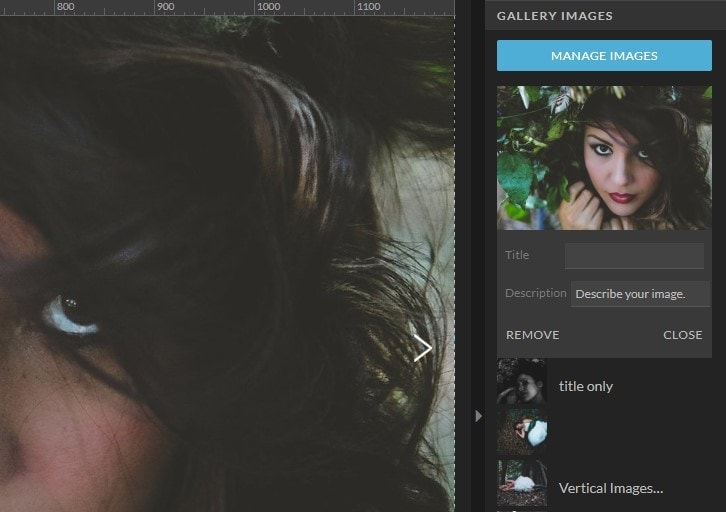
Canvas background
The final way to add an image in Showit is to add the image as a background on a canvas. When you set a canvas background, there are no additional SEO settings available. This is not necessarily a problem for rankings, just be aware that if you are trying to add alt text to your images, you won’t be able to do so for canvas backgrounds.
Sitemap url
With Showit, the sitemap for your Showit pages and your WordPress Pages/Posts will be separate. Depending on how you are using Showit pages, you may want to submit this sitemap in Search Console. The sitemap for Showit pages can be found by adding /siteinfo.xml to the end of your domain.
For example: https://ablazephotography.com/siteinfo.xml
Design + SEO Best Practices on Showit
The Showit design library is full of beautiful templates, both free and paid options. You can also build your site from scratch, or mix and match templates. The best practices in this section should guide your decision making when choosing or building the template for your website.
Use canvas views carefully
Canvas views are one of the more unique features of Showit. They are actually very handy for several things. Specifically, they work well for slideshows (where you can control the entire contents of each slide, not just the photo or overlay text), testimonial sliders, or even displaying a gallery without the need to go to a new page.
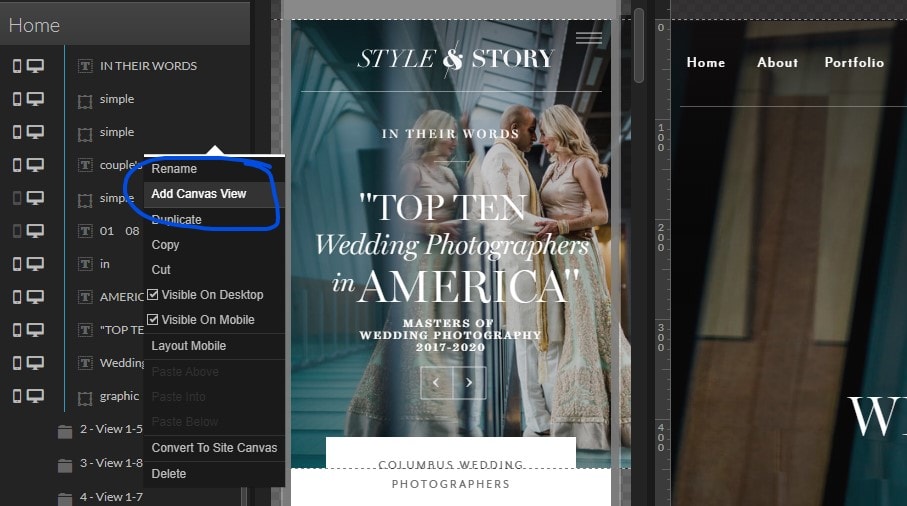
The way you can customize navigation between canvas views (any object can be turned into a control that hides or shows another canvas view) is something you won’t find in most other page builders.
From a technical standpoint, I actually like how Showit handles the contents of canvas views. Objects like images in sliders are “lazy loaded” and won’t hurt the performance score of your page. Google is still able to render and index content within canvas views that are not initially visible. However, there are some downsides to using canvas views, and with great design power comes great responsibility.
Here are a few things to consider when using canvas views:
- Google may prioritize initially visible content for ranking. Don’t put content that is critical for a good user experience in an initially hidden canvas view.
- Users expect a specific kind of navigation for certain functions, especially on mobile devices (like swiping through a slideshow). Don’t be so “creative” that you harm usability.
- Sometimes a canvas view makes the visitor feel like they are on a new page, but the navigation has changed and it can be confusing to get back. Be careful not to disorient visitors with a maze of canvas views (this is very common on Showit templates with multiple galleries as canvas views).
- Don’t use a canvas view to load content that could have been an independent page that would likely receive search traffic.
- If you want to track your form submissions in Google Analytics, you may be better off using a thank you page than a thank you canvas view after form submission.
Pay attention to object order
Layer order is another thing that isn’t quite intuitive on Showit. The order of the objects determines how they show up in the HTML of the page. The objects at the bottom of the layer list will show up first in the HTML. Check out these images for an example of the layer order, and the rendered HTML.
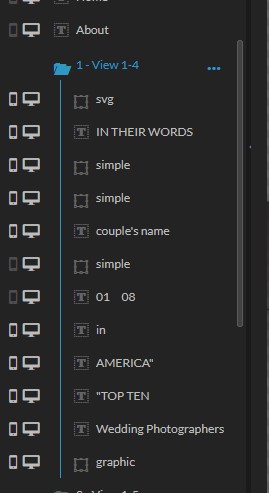
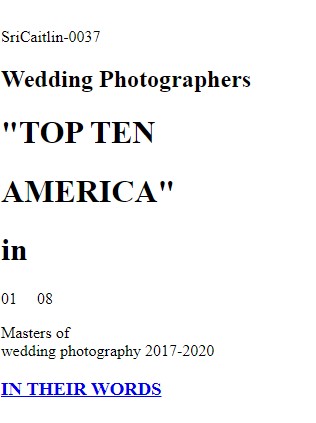
Keep in mind that with a drag and drop page builder, what you see visually is not always what search engine crawlers will see.
Here are 3 tools to help you view a “text only” version of your website so you can get a better idea of what Google may be seeing:
- The Google cache (text only version). Just go to Google or the address bar in Chrome and type cache:yourdomain.com and press enter (replace yourdomain.com with your actual domain). When that loads, click the “text only version” link. This webcache won’t always be available, so if this doesn’t work for you, try one of the next 2 tools.
- Textise – just paste in your URL and press the Textise button!
- w3td Text Browser Tool – again, just enter your URL and press browse!
Don’t use multiple fonts for one line of text
This is pretty common with Showit designs because, well… you can. When you look at the code for this example, you’ll see that these two lines get inserted as two separate H1 headings.
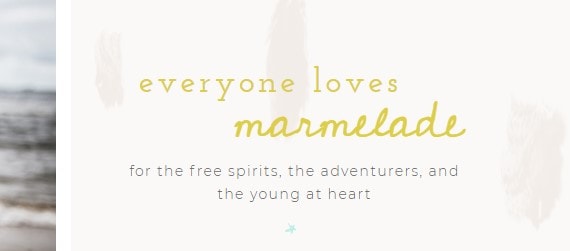
While it is possible to make one the H1 and the other a <div> or <p>, in the case of a main heading, that still isn’t optimal.
Speaking of <div> and <p>, let’s look at heading tags and other HTML elements available.
Heading and other element tags
In the Showit builder, any text element can have one of 6 possible HTML tags.
- <div> – A generic tag that stands for “division” (or section). Can be used safely anytime.
- <h1> – Your main heading. Use only once per page.
- <h2> – Subheadings for your page. Use for secondary topic headings.
- <h3> – Subheadings that belong to a parent H2.
- <nav> – Main navigation. ONLY use on main menus. Not buttons or other links.
- <p> – Paragraph. Another generic text tag that can be used safely anywhere.
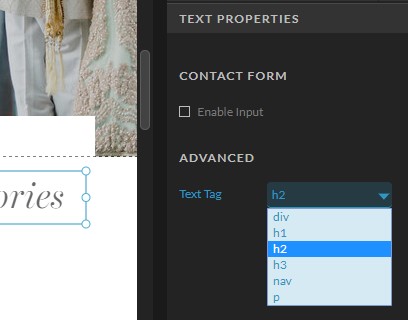
HTML headings (H1-H3) should be used to show the hierarchy of your page. An H1 should only be used once per page, to indicate the main topic. H2 and H3 tags can be used to create an “outline” for the rest of your content.
My favorite tool for looking at a pages heading structure is a Chrome extension called “headingsMap.” When enabled, you can see all of the headings in outline form, and quickly understand the topics covered on the page.
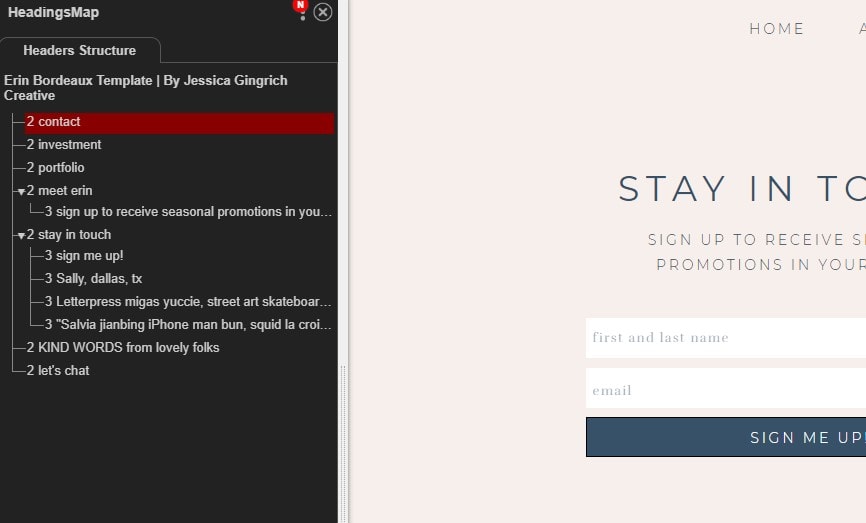
Anytime a text element is not part of your main navigation, and is not a heading that indicates content structure, you should use the <p> or <div> tag.
Use <nav>, not headings, on the main menu
I mentioned this above, but felt it deserves it’s own point. I see SO many Showit sites using heading tags for their main navigation. Do not use h1-h3 tags for your navigation. Use the <nav> tag, or even the <div> tag would be fine!
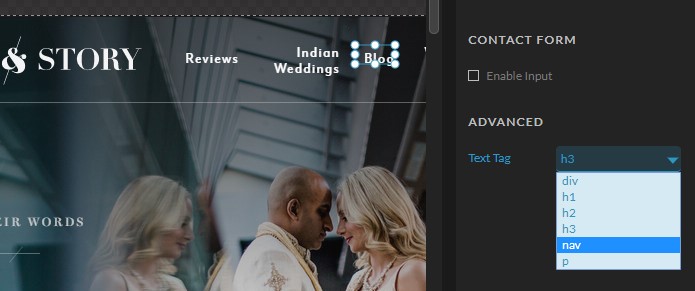
Be aware of “off canvas” items
With Showit, any “objects” that you place off of the visible canvas when editing your site will not be visible to website visitors. However, these objects will still show up in the code, and can be seen by search engines.
The most common problem I see is that template or demo content gets dragged off canvas, but not deleted when customizing the site. I’ve seen dozens of cases where that “Lorem Ipsum” content is being crawled by Google, and even triggering a “translate this page” option in search results.
Don’t duplicate items for mobile and desktop
Sometimes objects just aren’t as “responsive” as you’d like when they transform from one device to another. In any builder, it is sometimes easier to just create two separate versions of an object and then “hide” one on desktop and the other on mobile.
While this is sometimes unavoidable, it should be done extremely sparingly. Keep in mind that Google will likely see both variations, and will likely prioritize the mobile version.
What happens when you hide items from desktop or mobile?
For those of you who want to know what is happening behind the scenes…
If you hide an object on desktop AND mobile, it will not be rendered in the final HTML for the page. It will be invisible to both visitors and Google.
When you hide an item from one device or the other, a CSS property called “display: none” is applied for users at that screen size. Google will crawl/render/index both, but may de-prioritize objects using display: none.
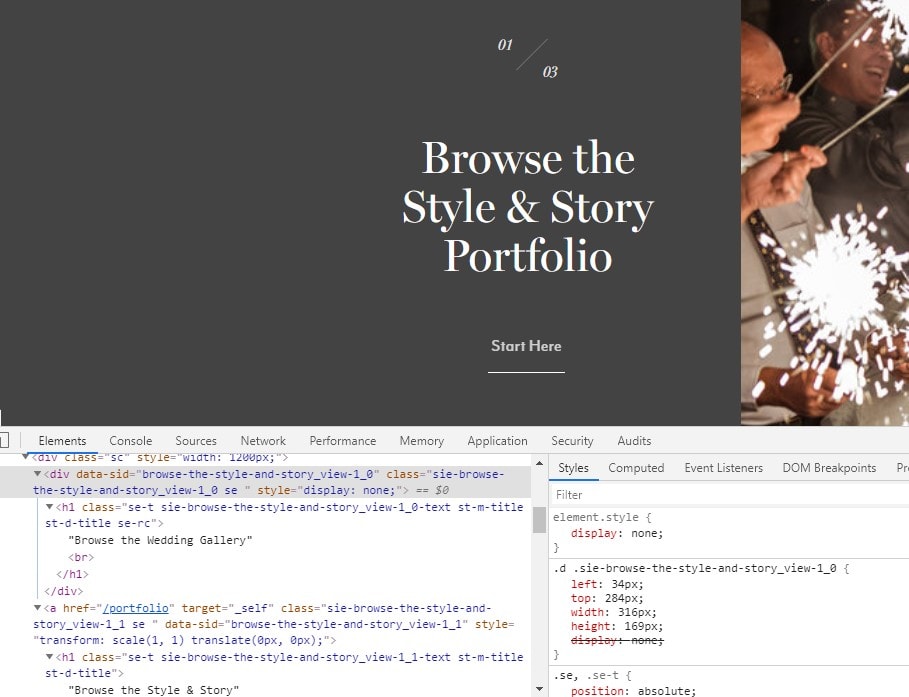
Using Showit as a WordPress Page Builder
The real beauty of Showit is that it can be used entirely as a WordPress page builder. Unfortunately, most users and designers do not utilize these capabilities. In this section, I’ll give an overview of how to truly integrate Showit and WordPress.
Showit pages vs Blog templates
In the “Site” tab of the left pane in the Showit builder, you will find “Pages,” “Blog Templates,” and “Site Canvases.”
For most Showit designs, the “Blog Templates” section will contain a Single Post template (the layout for a single post), a Blog template (for your list of posts), and sometimes a Page layout or 404 template.
What most Showit designers don’t take advantage of, and most Showiteers don’t even know, is that these templates are extremely flexible and can do so much more than just style the layout of a page, post, or 404.
In fact, the “Custom” option lets you create a template for anything in the WordPress template hierarchy! This is where I start to get excited about the possibilities with Showit.
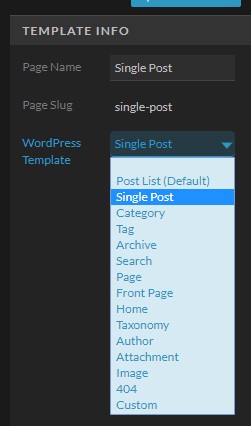
Benefits to using WordPress pages
The “Blog Templates” in the Showit builder act almost exactly like Showit pages. You can still use the Showit builder to design these templates, just like you would a Showit page. However, the templates introduce the ability to pull in dynamic content from WordPress!
One of my favorite benefits of using Blog Templates in Showit is the ability to add a “featured posts” section to the page. But the benefits of using a Blog Template don’t end there. Let’s examine a few other specific benefits.
Unified sitemap
Remember how earlier I mentioned that Showit has a separate sitemap for Showit Pages than WordPress posts/pages? I won’t get into all of the fringe case problems I’ve seen because of this in the past, but the nice thing about using WordPress pages with a Showit Blog Template is that those can be included in your main sitemap (like one generated with Yoast).
Consistent <head> section
This is where the SEO improvements can really come into play. Showit Pages and WordPress pages on Showit have completely different <head> sections. With WordPress pages, plugins like Yoast will write some additional code to the <head> of the page.
To observe this for yourself, use the Chrome browser, right click on your page, and click “Inspect.”
Here’s an example default head section for a Showit Page:
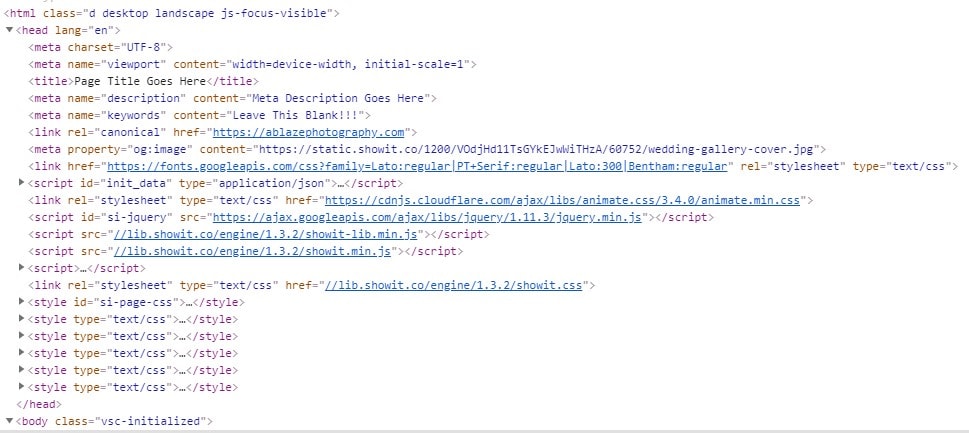
Here is an example of a blog post on Showit (this is on a demo site and is no-indexed on purpose):
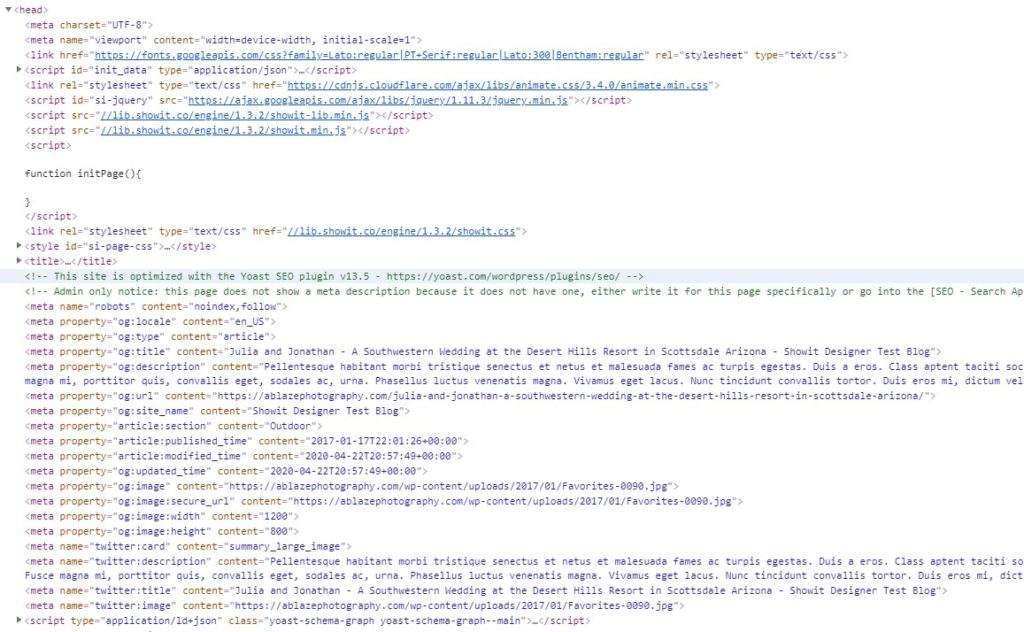
Notice the extra meta tags added with Yoast. Some of these will be irrelevant for some users, but the point is that you have more control, and all pages can follow a consistent format.
Ability to use plugins to control the page
As you can see in the examples above, when you use a WordPress page or post, you can use plugins to control what gets inserted into the head of each page or post. You can also use plugins to easily control other aspects of your WordPress pages and posts. If you are on the Advanced Blog package, the possibilities are endless. I’ve even created a custom plugin to extend the functionality of Showit.
Using all WordPress Templates instead of Showit Pages is *almost* like just using WordPress. Showit is then effectively a drag and drop WordPress page builder.
A few other plugins you might consider using:
- A Schema plugin like https://wordpress.org/plugins/wp-seo-structured-data-schema/
- ShortPixel for image optimization (note, I have not tested this thoroughly on Showit)
- Code Snippets – for adding custom code
Mapping a WordPress template to a WP page
The process of setting up a WordPress page and Blog Template in Showit is actually pretty easy when you get the hang of it. There are a couple of additional steps, which I think are enough to stop most people from taking advantage of all of the benefits.
The official Showit documentation for creating custom WordPress pages calls this technique “Advanced.” Don’t let that fool you, all it takes is setting up a page in WordPress, finding that page’s ID, and copying your Showit Page to a WordPress template. Easy Peasy.
If you do find this process intimidating, I have a video walk-through in our SEO course!
Keep in mind though, once you set up a page this way, you’ll need to handle the SEO settings on WordPress, not in the Showit SEO settings we covered earlier in this guide. Speaking of which…
Using Yoast
Yoast is our preferred SEO plugin, and you can use it on Showit, both with the Basic Blog and Advanced Blog packages.
Yoast will replace the SEO settings from the Showit builder. Here’s a screenshot of the main things it replaces directly:
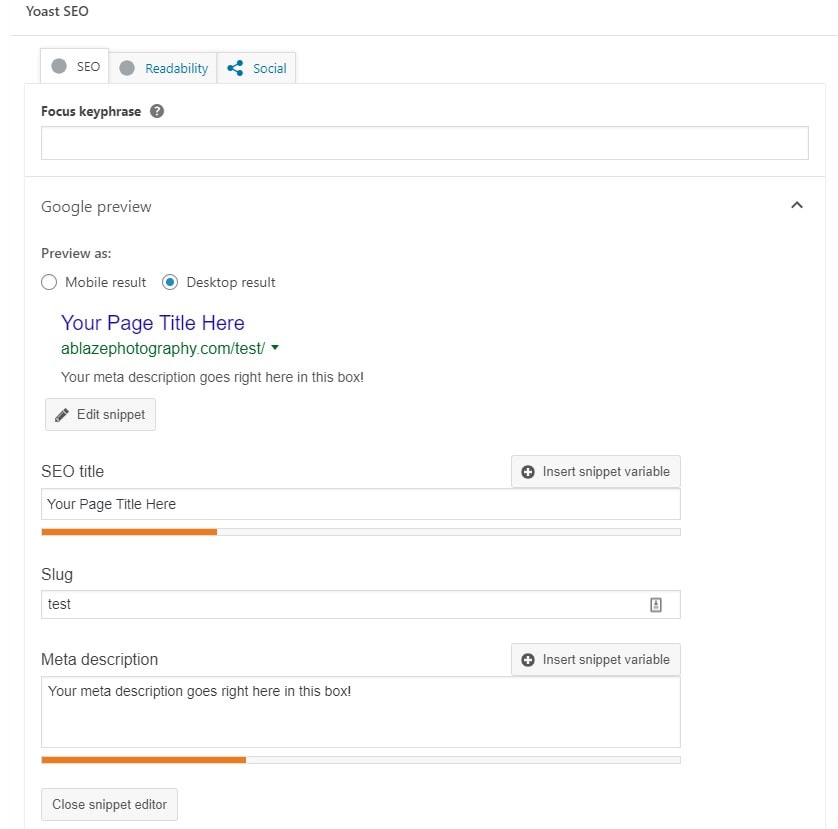
An important note is that you cannot use Yoast’s “SEO Analysis” if the page content is built mostly in the Showit Builder. Yoast will only recognize the content in the WordPress content area. In most cases, you are better off just leaving the “Focus keyphrase” box blank on any pages you’ve designed in the Showit Builder. That way you won’t be annoyed by the fact that you aren’t getting “green lights” in Yoast!
The WordPress Block Editor (Gutenberg) plus Showit
Since WordPress 5.0, the default WordPress editor has been the block editor (code name Gutenberg). At first, it was really glitchy, and most Showiteers decided to install the “Classic Editor” plugin so they didn’t have to switch to the block editor yet.
The block editor has come a long way since then, and is safe to use with Showit. On my test site, I’ve run into a few weird bugs that I’d like to figure out in the future (mostly the styling of the interface), but I was able to use the Block editor to create content as expected.
If you are just getting started with Showit and WordPress, I highly recommend that you get used to the block editor instead of installing the classic editor plugin!
Conclusion – What Does This Mean for Showit Users?
Do I recommend Showit?
I can really see why so many people love the flexibility offered with Showit. Their platform was innovative in several ways, especially several years ago when they launched Showit5.
However, there are several reasons that I do not feel comfortable recommending Showit.
- Many of the Showit “features” encourage users to create sites that are not user friendly.
- There is a good reason that responsive websites are built on a grid, and I think drag and drop builders are a recipe for disaster when it comes to cross browser/device compatibility.
- Most of the free designs I’ve tested, and many of the premium designs I’ve seen are setting users up for SEO failure from the start. They are pretty, but they don’t follow best practices.
- I’m worried that Showit’s technology is not future proof. They have a history of taking WAY to long to adapt to emerging technology (like phasing out Flash or including HTTPS). Want to make your site AMP compatible with Showit? Don’t even think about it.
- The free migration they offer is extremely “hit or miss.” In my experience, it is more often “miss” when it comes to SEO.
- Showit support is extremely friendly (I really do like their team), but I’ve had serious problems getting help with technical issues.
- I hate having to align things manually, and not having a grid to keep things perfectly spaced.
- The code that is generated by Showit sites is a MESS. Seriously, go do that cache: search I mentioned earlier on a few Showit sites (look at the text only version).
- All of the extra steps and workarounds needed just aren’t worth it. I can achieve at least 80% of the same thing with WordPress and Elementor, without the extra headaches and workarounds needed to make Showit work.
In short, the #1 advantage to Showit is that they have some of the most talented designers creating designs for them, and starting with an almost complete site only takes a few clicks.
All of that being said, because Showit CAN be used as a WordPress page builder, and because you CAN keep your design simple and follow best practices, Showit still comes in (a distant) second or third on my list of top recommended website platforms for photographers.
If you need help maximizing your Showit site’s potential in search engines, you can hire us for hourly consulting here!
Showit professionals you can trust
I’ve worked on dozens (if not hundreds) of Showit sites, so I’ve come to know it pretty well. However there are a few people who have helped me personally when I have Showit questions. A special thanks to:
Crystal Lee Design Studio – Crystal has been a friend for a long time, and really knows her stuff when it comes to Showit.
Melissa Love – Melissa is a pro when it comes to all things WordPress and design. This includes Showit, but also ProPhoto and Divi!
Rachael Earl – Rachael always seems to have the answers to the complicated WordPress + Showit questions!
Showit Design Partners – Showit is very selective about who they recommend, and have a list of design partners here!
Showit User Group – A Facebook community with thousands of Showit users and designers.
Showit alternatives
If you like the idea of Showit, but want to check out some alternatives, here are a couple that may interest you.
Flex themes by Flothemes
Flothemes recently released their new FlexBlock and “flex” themes, which include a drag and drop block that feels alot like Showit! In many ways, I find their builder even more intuitive, and I really love the features they are introducing. At this point, it still isn’t as full featured as Showit, but it is a great alternative, especially if you only need drag and drop functionality on specific sections of your site.
Elementor
My favorite option for people who need a visual page builder is Elementor.
With Elementor, you can use a lightweight WordPress theme like Hello or Astra, and then build anything you can imagine with Elementor.
While it isn’t fully drag and drop like Showit, it is possible to drag and drop elements in Elementor, and everything else is based on a responsive grid system. Elementor isn’t a *perfect* solution, but when it comes to page builders with LOTS of flexibility, Elementor is hard to beat.
Other Showit Questions
Do you have more questions about Showit SEO? Leave a comment below and we’ll do our best to find you an answer!
It is possible to have a site that ranks very well on Google with Showit. For most users, there are some major considerations and extra steps you’ll need to take if you want your SEO to be excellent. In many ways, SEO for your Showit site is going to be exactly the same as SEO for any other website builder or platform.
Showit has three plans you can choose when you sign up. The “Showit” package, the “Showit + Basic Blog” package and the “Showit + Advanced Blog” package. If you are serious about SEO, you really shouldn’t consider any package other than the Advanced Blog package.
Showit can integrate with WordPress and act as a page builder for WordPress posts and pages. However, Showit pages are completely different than WordPress pages or posts.


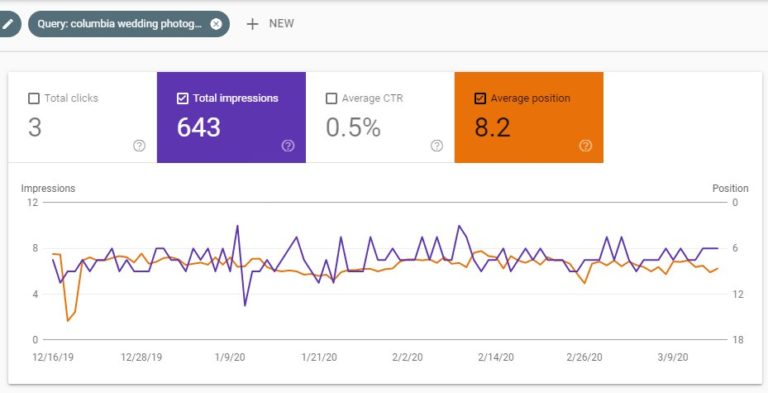

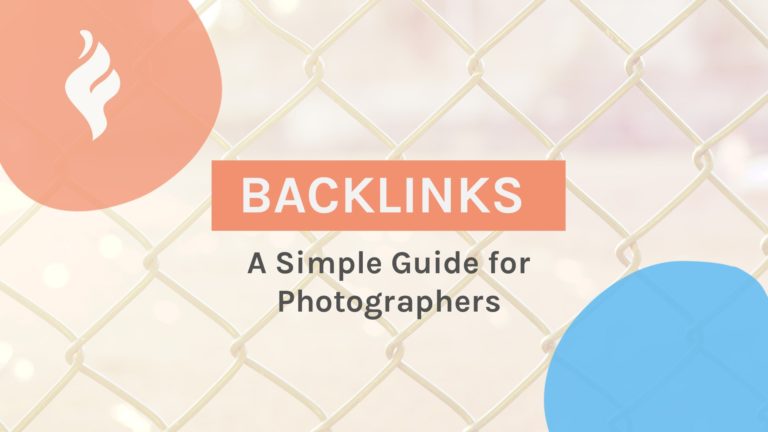
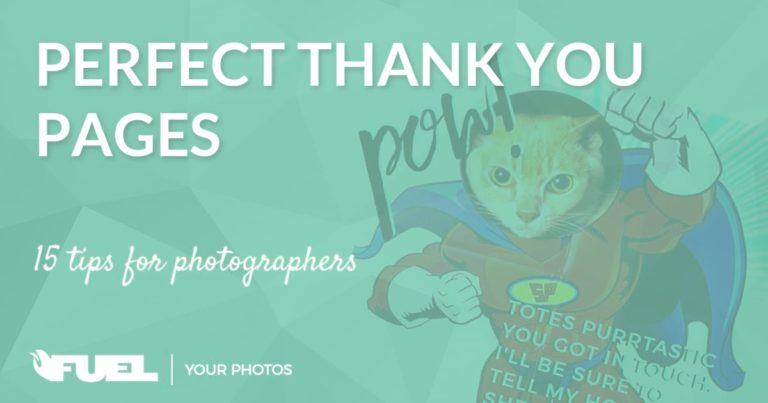


Great article Corey. Thanks for putting this together. My business offers photo AND video, so I’d like to showcase a few videos on my site, but the way I have it set up right now is making my site speed suffer. What would be the best practice for adding video without sacrificing speed?
I think there will always be SOME speed tradeoff when you want to use videos, but there are certainly ways to minimize the impact. I’m still experimenting with video embeds on Showit, and haven’t found a perfect solution yet. That being said, Showit + video isn’t my main area of expertise, and you may find someone in the Showit community who has already solved this!
Good article…really thought provoking! I am currently on Showit and am thinking of transitioning to Elementor. At the end of the day, is it worth the effort to “rebrand” myself on another platform and basically start from scratch or should I just just try and maximize any SEO from Showit?
Great question! I think it really depends alot on your personal preferences and goals. I’ve certainly seen cases where it makes more sense to just stick with Showit and maximize the capabilities of the platform. Some things to consider:
Ultimately, you’ll need to decide what works best for you and your business. Every platform, theme, or design will have their own pros and cons, you just have to decide which ones fit best with your needs!
This is exactly what I needed, thank you!!
Hi! Is this info still relevant? Do you have any plans to update this article? Thanks!
Yes, the info here is still relevant. I’ve made slight updates since it was published as things have changed with Showit. To be honest, not much is changing with Showit 😉 Is there anything in particular that you feel needs an update from this article? I know there are a few screenshots that aren’t 100% up to date, and perhaps a few small things that have changed, but overall it should still be very useful!
Thank you, this was really helpful! I have a Tonic template for Showit, and I went through this entire thing, and thankfully, I didn’t have to change much to optimize it.